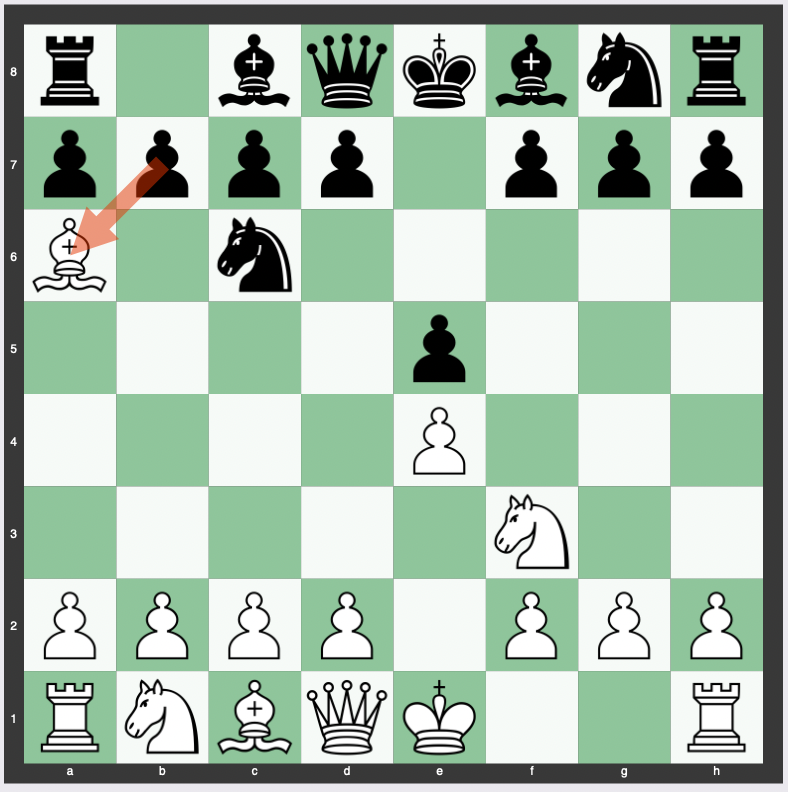In chess, pawns have a unique way of moving and capturing. A pawn moves straight forward one square (with an option to move two squares forward from its starting position) but captures diagonally.
- Moving: If a pawn is on its starting rank (for white, this is rank 2; for black, this is rank 7), it has the option to move forward one square or two squares. However, it does not capture by moving straight forward.
- Capturing: A pawn can capture an enemy piece on its first move if and only if an enemy piece is diagonally in front of it on an adjacent file. It cannot capture by moving two squares forward, nor can it capture by moving straight forward.
Examples of a Pawn Capturing on Its First Move
Let’s look at a couple of examples:
Example #1
In certain lines of the Sicilian Defense, black will sac its bishop on a3 in order to move the b-pawn to a3 to capture the bishop.

Then black can:
- capture the knight with the queen with check, then retake the pawn on a3, creating a material advantage, or
- take the bishop on d3 with the knight
Example #2
Let’s say we’re about to enter the Ruy Lopez, but white mouse slips and puts the bishop on a6 instead of b5.
In this case, black will gladly capture the bishop with its b7 pawn on its first move.

Q&A – Can a Pawn Capture on Its First Move?
What is a pawn’s first move in chess?
In chess, on its first move, a pawn has the option to move forward either one or two squares, provided those squares are unoccupied.
This option to move two squares forward only applies to the pawn’s very first move and not to subsequent moves.
Can a pawn capture another piece on its initial move?
A pawn captures diagonally, and if there is an opponent’s piece on an adjacent diagonal square in front of the pawn (even on its first move), the pawn can capture it by moving to that square.
However, the pawn cannot capture by moving straight forward, even if it’s just one square.
How does a pawn capture in chess?
A pawn captures diagonally.
It moves one square diagonally forward (to the left or right) to the square occupied by an opponent’s piece and captures that piece.
What is the difference between a pawn’s normal move and its capturing move?
A pawn’s normal move is to move straight forward by one square (or by two squares on its first move if both squares are unoccupied).
On the other hand, a pawn’s capturing move is to move one square diagonally forward, either to the left or right, to capture an opponent’s piece. A pawn cannot move diagonally unless it’s capturing.
Is there a special move for pawns called “en passant”?
Yes, there is a special pawn capturing move called “en passant” (which means “in passing” in French).
This move can occur when a pawn moves two squares forward from its starting position and lands beside an opponent’s pawn.
In this situation, the opponent’s pawn has the option, on the very next move, to capture the first pawn “en passant” as if it had only moved one square forward.
Can a pawn move two squares forward on its first move without capturing?
Yes, a pawn can move two squares forward on its first move without capturing, provided both squares directly in front of it are unoccupied.
This is a unique ability of the pawn and can only be done on its very first move.
What happens if an opponent’s piece is directly in front of a pawn on its first move?
If an opponent’s piece is directly in front of a pawn on its first move, the pawn cannot move forward two squares.
In fact, it can’t move forward at all until the blocking piece is removed or moved.
The pawn can still capture diagonally if an enemy piece is on an adjacent diagonal square.
Can pawns capture diagonally?
Yes, pawns capture by moving one square diagonally forward to the left or right.
This is the only way a pawn can capture an opponent’s piece.
Are there any exceptions to how a pawn captures?
The primary exception to the standard diagonal capturing method of pawns is the “en passant” rule mentioned earlier.
Under specific conditions, a pawn can capture another pawn that has just moved two squares forward from its starting position by moving into the square the opponent’s pawn skipped over.
How does the rule of “en passant” relate to a pawn’s first move?
The rule of “en passant” directly relates to a pawn’s first move.
When a pawn uses its unique ability to move two squares forward on its first move and ends up directly beside an opponent’s pawn, the opponent has the option to capture the first pawn “en passant” on the very next move.
This essentially treats the pawn that moved two squares as if it had moved only one, allowing for its capture.


